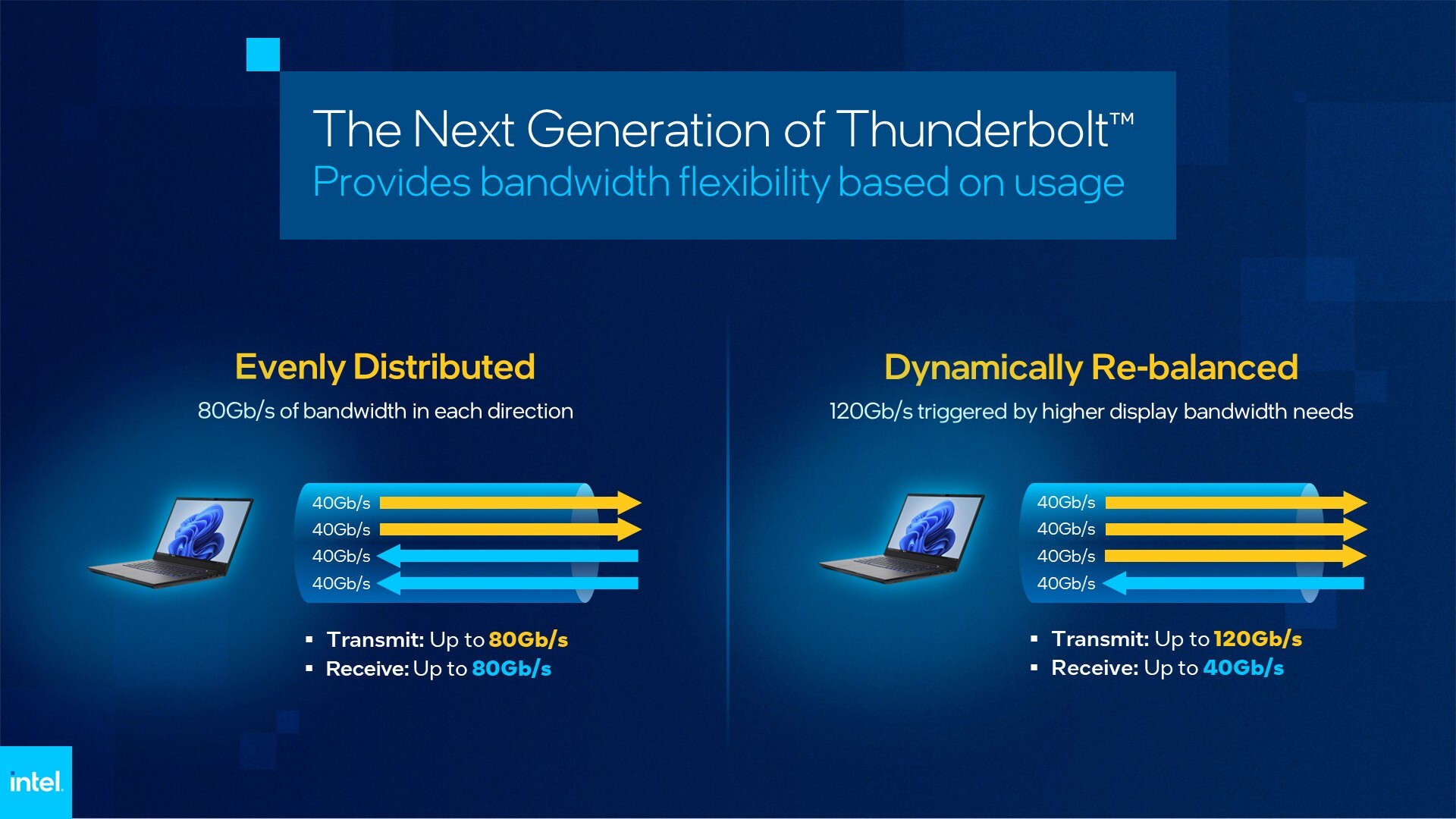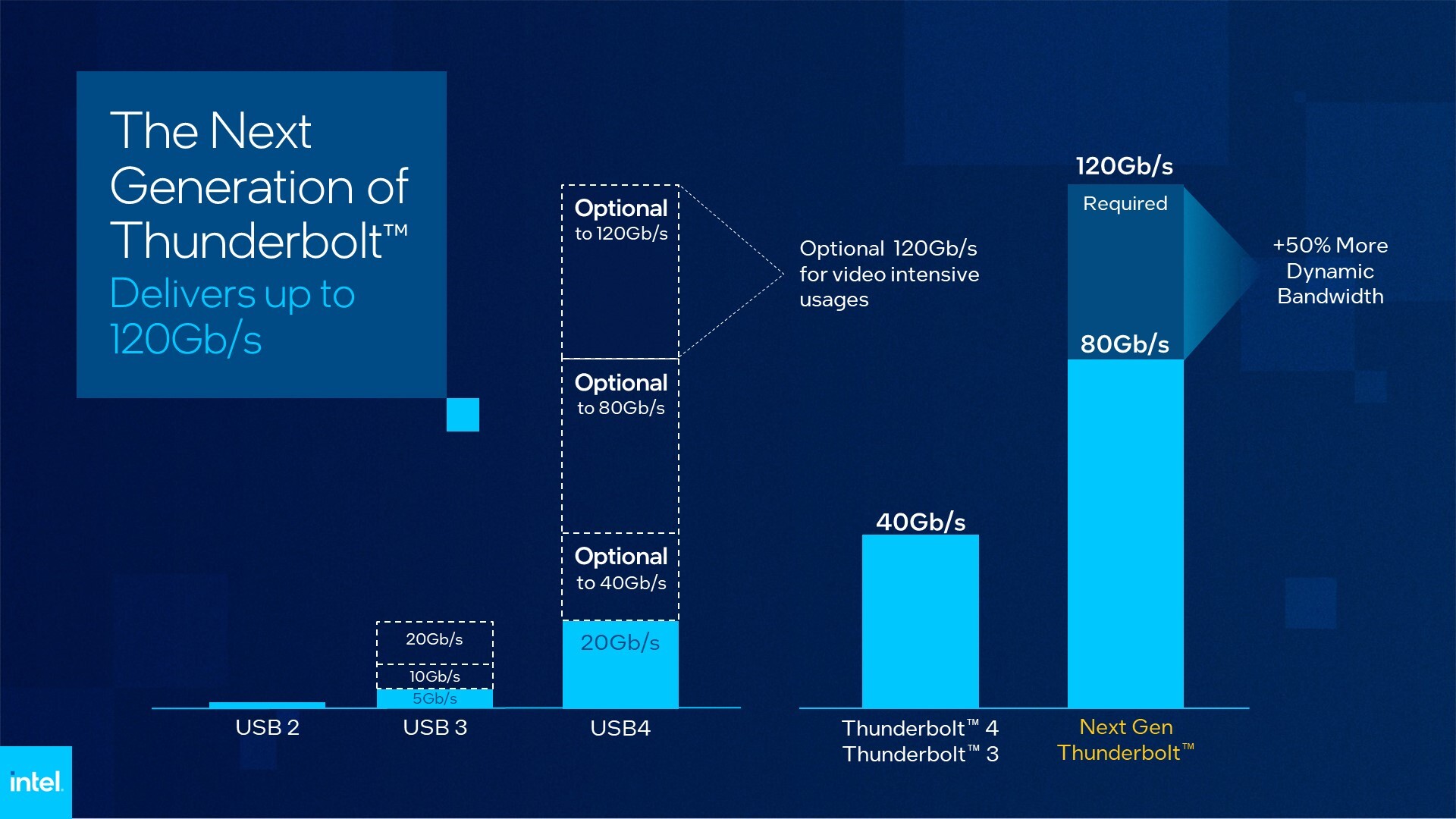Intel's Next-Gen Thunderbolt Can Hit 120 Gbps — Sometimes
80 Gbps specifically for data, but no name yet for the Thunderbolt 4 successor.
Following the launch of the USB 4 version 2, Intel is further detailing its next-gen Thunderbolt port, which the company says will align with the USB Implementer Forum's spec, while offering DisplayPort 2.1as well.
At Intel's Development Center in Haifa, Israel, the company demonstrated the new Thunderbolt connector's 80 GBps connection, twice that of Thunderbolt 4. Today, Intel has a new demonstration, carefully worded as a "prototype," that allows for 120 Gbps in "video-intensive usages."
Typically, the new Thunderbolt connection (which Intel has yet to name, although Thunderbolt, Thunderbolt 2, Thunderbolt 3 and Thunderbolt 4 are taken), equally allocates its lanes to both transmit and receive up to 80 Gbps simultaneously. But when connected to a display that requires more bandwidth (perhaps an 8K monitor), the new interface can take over some of the transmission-based connection, lowering how much you can receive and pushing more data.
Yesterday, the USB-IF announced a similar asymmetrical signal interface to deliver 120 Gbps transmission, while staying at 40 Gbps going the other way. So we'll see at some point if there are any differences in how they work. USB 4 is also getting 80 Gbps operation, similar to what is described in Thunderbolt.
While Intel mentions that Thunderbolt is "aligned" to the latest USB specification, it's also clear that the company feels Thunderbolt is more of a sure thing. Specifically, the company has a slide detailing all of the "optional" features in USB 4, including any speeds above 20 Gbps, while the next-gen Thunderbolt will require both 80 Gbps speeds and up to 120 Gbps for certain video workloads all the time. In short, Intel claims that if you get Thunderbolt, you'll get a better experience with more guaranteed results.
The new Thunderbolt connectors are also designed to work with passive cables already on the market, up to one meter in length, as well as support up to twice the PCI Express data throughput as previous specs, which could allow for better gaming.
The USB 4 Version 2 initiative has a series of new logos showing the kinds of speeds that cables and accessories can push. The question is how many manufacturers will actually use them. Meanwhile, Intel hasn't named this new version of Thunderbolt, so it's unclear how the company will market the new connection to showcase its advantages.
Thunderbolt technology has been found primarily on laptops, including Windows PCs, Linux machines, Macs and Chromebooks. But Intel licenses Thunderbolt connections, and we've seen very few devices without Intel processors using the Thunderbolt name.
Get Tom's Hardware's best news and in-depth reviews, straight to your inbox.

Andrew E. Freedman is a senior editor at Tom's Hardware focusing on laptops, desktops and gaming. He also keeps up with the latest news. A lover of all things gaming and tech, his previous work has shown up in Tom's Guide, Laptop Mag, Kotaku, PCMag and Complex, among others. Follow him on Threads @FreedmanAE and BlueSky @andrewfreedman.net. You can send him tips on Signal: andrewfreedman.01
-
PlaneInTheSky ReplyIntel is further detailing its next-gen Thunderbolt spec, which will support 80 GBps transfers and up to 120 GBps for video.
80GBps? are you sure? seems like a lot -
jkflipflop98 Hehe. 120 gigabytes a second would be a lot for today. In a few years that will be normal.Reply
I remember driving home giddily after spending $500 on a 200MB hard drive. "I'll never need another hard drive! This thing is cavernous!" -
smirnof12 Replygfg said:80 Gbps <> 80 GBps
Giga bits <> Giga Byte
8 bits = 1 byte ->> 80 Gbps = 80/8 = 8 GBps
you mean 80/8=10 GBps, right? ;-) -
hotaru251 Reply
few yrs? no.jkflipflop98 said:Hehe. 120 gigabytes a second would be a lot for today. In a few years that will be normal.
generally these don't get wide spread fast and they advance slower the longer you go.

